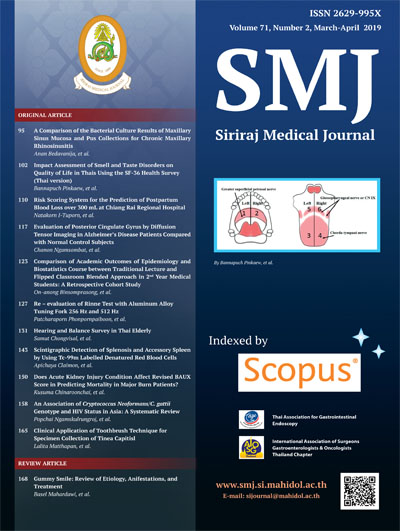Risk Scoring System for the Prediction of Postpartum Blood Loss over 300 mL at Chiang Rai Regional Hospital
DOI:
https://doi.org/10.33192/Smj.2019.17Keywords:
Risk score; postpartum blood loss; vaginal delivery; Chiang Rai Regional HospitalAbstract
Objective: To develop an assessment tool for the prediction of postpartum blood loss over 300 mL and 500 mL
after vaginal delivery.
Methods: A retrospective case-control study of 504 (72 cases: 432 controls) pregnant women with gestational age
of 28 weeks or above who underwent vaginal delivery at Chiang Rai Regional Hospital between 1st October 2015
and 30th September 2016 was conducted. The predictors were selected using “Sign OK” selection. The risk scoring
system was developed according to the seven steps of clinical prediction model development of Steyerberg.
Results: This form included eight predictors: maternal age of 35 years old or above, gestational age over 40 weeks,
being nulliparous, history of curettage in prior pregnancy, gestational hypertensive disorder, hemoglobin level
equal to or less than 10 g/dL, fundal height of 38 centimeters or above, and the use of pethidine for pain relief in
the 1st stage of labor. The sensitivity of predicting postpartum blood loss over 300 mL after vaginal delivery by the
risk scoring system was 80.7%, specificity of 60.8%, and the ROC curve was equal to 0.71 at the optimal cut-off
score of four points or above. To predict the postpartum blood loss of 500 mL or above after vaginal delivery, the
sensitivity was 88.1%, specificity of 54.6%, and the ROC curve was equal to 0.71 at the optimal cut-off score of three
points or above.
Conclusion: This form had an acceptable performance in predicting postpartum blood loss over 300 mL and 500
mL at the optimal cut-off scores of four points or above and three points or above, respectively.
Downloads
Published
How to Cite
Issue
Section
License
Authors who publish with this journal agree to the following conditions:
Copyright Transfer
In submitting a manuscript, the authors acknowledge that the work will become the copyrighted property of Siriraj Medical Journal upon publication.
License
Articles are licensed under a Creative Commons Attribution-NonCommercial-NoDerivatives 4.0 International License (CC BY-NC-ND 4.0). This license allows for the sharing of the work for non-commercial purposes with proper attribution to the authors and the journal. However, it does not permit modifications or the creation of derivative works.
Sharing and Access
Authors are encouraged to share their article on their personal or institutional websites and through other non-commercial platforms. Doing so can increase readership and citations.















